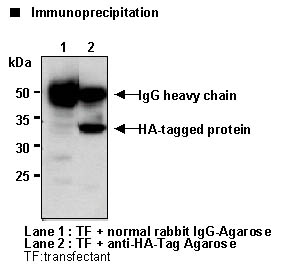Anti-HA-tag pAb-Agarose
| Code | Size | Price |
|---|
| MBL-561-8 | 400 ul | £307.00 |
Quantity:
Prices exclude any Taxes / VAT
Overview
Host Type: Rabbit
Antibody Isotype: IgG
Antibody Clonality: Polyclonal
Regulatory Status: RUO
Target Species: Multiple species
Application: Immunoprecipitation (IP)
Shipping:
4°C
Storage:
4°C
Images
Documents
Further Information
Applications:
IP - 20 uL
Background:
Epitope tagging has widely been accepted technique that fuse an epitope peptide to a certain protein as a marker for gene expression. With this technique, the gene expression can be easily monitored on western blotting, immunoprecipitation and immunofluorescence utilizing with an antibody that recognizes such an epitope. Amino acid sequences that are widely used for the epitope tagging are as follow; YPYDVPDYA (HA-Tag), EQKLISEEDL (Myc-Tag) and YTDIEMNRLGK (VSV-G-Tag), which corresponding to the partial peptide of Influenza hemagglutinin protein, human c-myc gene product and Vesicular stomatitis virus glycoprotein respectively.
Conjugate:
Agarose
Formulation:
540 mg of anti-HA Tag polyclonal antibody covalently coupled to 200 mL of agarose gel and provided as a 50% gel slurry suspended in PBS containing preservative (0.09% sodium azide) for a total volume of 400 mL.
Immunogen Translated:
YPYDVPDYA (HA-tag)-KLH
Reactivity:
This antibody recognizes HA-tag
peptide sequence (YPYDVPDYA) on
Immunoprecipitation.
Shelf Life:
1 year
Source:
This antibody was purified from rabbit serum
using affinity colomn. The rabbit was immunized with
carrier protein (CP) conjugated synthetic peptide,
CP-YPYDVPDYA (HA-tag).
Target:
HA
References
1) Sun, P., et al., Genes Cells 11, 1097-1113 (2006)
2) Arao, Y., et al., Mol. Endocrinol 18, 2255-2267 (2004)
3) Myojin, R., et al., Biol. Reprod 71, 926-932 (2004)
4) Zhang, A., et al., J. Biol. Chem. 279, 33799-33805 (2004)
5) Murayama, Y., et al., J. Cell Sci. 117, 3379-3388 (2004)
6) Saito, T. T., et al., Nucleic Acids Res. 32, 3325-3339 (2004)
7) Toji, S., et al., Genes Cells 9, 383-397 (2004)
8) Yasuda, S., et al., Endocrinology 145, 1730-1738 (2004)
9) Sekiguchi, T., et al., J. Biol. Chem. 279, 8343-8350 (2004)
10) Abe, T., et al., J. Cell Sci. 116, 155-168 (2003)
11) Sun, P., et al., J. Biol. Chem. 278, 4063-4071 (2003)
12) Furusawa, M., et al., J. Biol. Chem. 277, 50885-50892 (2002)
13) Katsu, R., et al., J. Biol. Chem. 277, 44220-44228 (2002)
14) Zama, T., et al., J. Biol. Chem. 277, 23909-23918 (2002)
15) Nishizawa, H., et al., J. Biol. Chem. 277, 1586-1592 (2002)
16) Kamimoto, T., et al., J. Biol. Chem. 276, 37520-37528 (2001)
17) Kojima, T., et al., J. Biol. Chem. 276, 32247-32256 (2001)
18) Sekiguchi, T., et al., J. Biol. Chem. 276, 7246-7257 (2001)
19) Izumi, M., et al., Nucleic Acid Res. 28, 4769-4777 (2000)
20) Matsuda, S., et al., J. Biol. Chem. 274, 34515-34518 (1999)
21) Takahashi, M., et al., J. Virol. 73, 7812-7816 (1999)
22) Koizumi, J., et al., J. Biol. Chem. 274, 11125-11131 (1999)
23) Kondo, T., et al., Mol. Cell Biol. 19, 1136-1143 (1999)
24) Furuse, M., et al., J. Cell Biol. 143, 391-401 (1998)
25) Shimomura, T., et al., Mol. Cell Biol. 18, 5485-5491 (1998)



